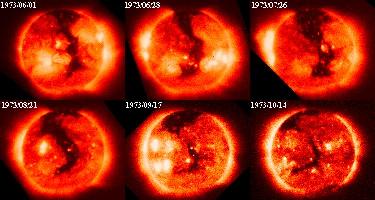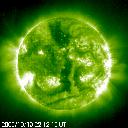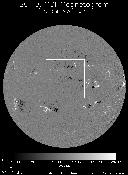
Coronal holes are large-scale coronal features where plasma density is extremely low, and thus they look like a hole or a void in the corona. They often appear in polar regions and are thought to be areas where the magnetic field is open to space. They are also known as the base of high-speed coronal wind. The first continuous observations of these structures were made with Skylab in the 1970s in soft X-rays. Coronal holes sometimes take the shape of channels rather than round holes, and may hold their shape though several rotation of the sun.

A movie of the Skylab observations is linked here. More details will be found in the following address:
Shown in the above is a famous coronal hole observed with Skylab in 1973. It is well known by the nickname of "The Boot of Italy" after its elongated shape. An interesting fact is that coronal holes seem to rotate like rigid bodies, while sunspots are known to rotate faster in the equatorial zone and slower in higher latitude zones. This raises questions about how the relationships of coronal holes and the neighbouring sunspots change through the rotations. Do the sunspots shove past across channels? This nugget does not clearly solve this question, but will provide a viewpoint which may help to guide future observations.

September 2000: Still -- MPEG Movie -- |
October 2000: Still -- MPEG Movie -- |
Comparing two images which show the very extensive coronal hole near the central meridian passage during two recent rotations, we can see that the "channel" has come back to the same place in 27 days without largely changing its straight shape. This suggests that the coronal hole may rotate like a rigid body at the corresponding period. On the other hand, the active regions located on each side of the channel, seem to proceed faster than the channel, and slightly distort the shape of the channel. (In the present case, they made the channel more straight and stylish, though!)
 KitPeak 10830 image |
 SOHO/EIT 195 image |
 SOHO/EIT 171 image |
 SOHO/MDI image |
You may have noticed from the October images that the coronal hole seemed to extend from pole to pole. More than a "neat" appearance, it is a bit of a puzzle: How can it be a continuous feature, since the north and south poles must have different magnetic polarities? To see this more closely, we should consult with the magnetic fields, which we showed above. It is found from the MDI image that the coronal hole in question has primarily negative polarity, the same polarity as the current south pole. The polarity appears to be uniform through its whole stretch. With a stretch of imagination, we might say that we caught the negative polarity just invading the north pole.
October 20, 2000
Aki Takeda <takeda@isass0.solar.isas.ac.jp>